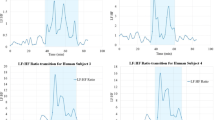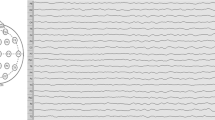Abstract
Driver drowsiness, fatigue and inattentiveness are the major causes of road accidents, which lead to sudden death, injury, high fatalities and economic losses. Physiological signals provides information about the internal functioning of human body and thereby provides accurate, reliable and robust information on the driver’s state. In this work, we detect and analyse driver’s state by monitoring their physiological (ECG) information. ECG is a non-invasive signal that can read the heart rate and heart rate variability (HRV). Filters are applied on the ECG data and 13 statistically significant features are extracted. The selected features are trained using three classifiers namely: Support Vector Machine (SVM), K-nearest neighbour (KNN) and Ensemble. The overall accuracy for two-classes such as: normal–drowsy, normal–visual inattention, normal–fatigue and normal–cognitive inattention is 100%, 93.1%, 96.6% and 96.6% respectively. The result shows that two-class detection provides better accuracy among different states. However, the classification accuracy using Ensemble classifier came down to 58.3% for five-class detection. In the future, better algorithms have to be developed for improving the accuracy of multiple class detection.









Similar content being viewed by others
References
Seetharaman G (2019) Indian road: fatalities in mishaps high despite better construction and use of tech, Economic Times of India
Koesdwiady A, Soua R, Karray F, Kamel MS (2016) Recent trends in driver safety monitoring systems: state of the art and challenges. In: IEEE transactions on vehicular technology. vol 9545, pp 1–1
Arun S, Sundaraj K, Murugappan M (2012) Hypovigilance detection using energy of electrocardiogram signals. J Sci Ind Res (India) 71(12):794–799
Pratama BG, Ardiyanto I, Adji TB (2017) A review on driver drowsiness based on image , bio-signal, and driver behaviour. In: 2017 3rd international conference on science and technology-computer (ICST). IEEE, pp 1–6
Awais M, Badruddin N, Drieberg M (2017) A hybrid approach to detect driver drowsiness utilizing physiological signals to improve system performance and Wearability. Sensors (Switzerland) 17(9):1–16
Chui KT, Tsang KF, Chi HR, Ling BW, Wu CK (2016) An accurate ECG-based transportation safety drowsiness detection scheme. IEEE Trans Ind Inform 12(4):1438–1452
Husodo AY, Hermawan I, Boediman A, Driver AC, Detection D (2018) Multi-parameter measurement tool of heart rate and blood pressure to detect Indonesian car drivers drowsiness. In: 2018 3rd international seminar on sensors. instrumentation, measurement and metrology (ISSIMM), pp 68–73
Council ETS (2002) The role of driver fatigue in commercial roaf transport crashes
Dong Y, Hu Z, Uchimura K, Murayama N (2011) Driver inattention monitoring system for intelligent vehicles: a review. IEEE Trans Intell Transp Syst 12(2):596–614
Sahayadhas A, Sundaraj K, Murugappan M (2014) Electromyogram signal based hypovigilance detection. Biomed Res 25(3):281–288
Bogunovic N, Jovic A (2010) Processing and analyisis of biomedical nonlinear signals by data mining methods. In: 17th International Conference on Systems, Signals and Image Processing, IWSSIP, pp 276–279
Jovic A, Bogunovic N (2010) Classification of biological signals based on nonlinear features. In: 15th IEEE mediterranean electrotechnical conference, pp 1–6
Begum S (2013) Intelligent driver monitoring systems based on physiological sensor signals: a review. In: International IEEE conference on intelligent transportation systems ITSC, pp 282–289
Khushaba RN, Kodagoda S, Lal S, Dissanayake G (2011) Driver drowsiness classification using Fuzzy wavelet-packet-based feature-extraction algorithm. IEEE Trans Biomed Eng 58(1):121–131
Tanaka M et al (2015) Frontier studies on fatigue, autonomic nerve dysfunction, and sleep-rhythm disorder. J Physiol Sci 65(6):483–498
Sun Y, Yu X (2014) An innovative nonintrusive driver assistance system for vital signal monitoring. IEEE J Biomed Health Inform 18(6):1932–1939
Zhao C, Zhao M, Liu J, Zheng C (2012) Electroencephalogram and electrocardiograph assessment of mental fatigue in a driving simulator. Accid Anal Prev 45:83–90
Wang L, Wang H, Jiang X (2017) A new method to detect driver fatigue based on EMG and ECG collected by portable non-contact sensors, Promet Traff Trans, 29(5), 479–488
Kawanaka H, Miyaji M, Bhuiyan S, Oguri K (2013) Identification of cognitive distraction using physiological features for adaptive driving safety supporting system. Int J Veh Technol 2013:1–18
Warwick B, Symons N, Chen X, Xiong K (2015) Detecting driver drowsiness using wireless wearables. In: 2015 IEEE 12th international conference on mobile ad hoc and sensor systems, pp 585–588
Sahayadhas A, Sundaraj K, Murugappan M, Palaniappan R (2015) A physiological measures-based method for detecting inattention in drivers using machine learning approach. Biocybern Biomed Eng 35(3):198–205
Velayudhan A, Peter S (2016) Noise analysis and different denoising techniques of ECG signal: a survey. In: IOSR journal of electronics and communication engineering, pp. 40–44
Fu R, Wang H (2014) Detection of driving fatigue by using noncontact EMG and ECG signals measurement system. Int J Neural Syst 24(3):1–15
Karegar FP, Fallah A, Rashidi S (2017) ECG based human authentication with using generalized hurst exponent. Iran Conf Electr Eng 17:34–38
Soman K (2014) Classification of stress of automobile drivers using radial basis function Kernel support vector machine. Int Conf Inf Commun Embed Syst 978:1–5
Deb S, Islam SR, Johura FT, Huang X (2017) Extraction of linear and non - linear features of electrocardiogram signal and classification. In: 2017 2nd international conference on electrical & electronic engineering, Dec, pp 1–4
Nahvi A, Mahmoodi M (2019) Driver drowsiness detection based on classification of surface electromyography features in a driving simulator. J Eng Med 233(4):395–406
Sahayadhas A, Sundaraj K, Murugappan M (2013) Drowsiness detection during different times of day using multiple features. Australas Phys Eng Sci Med 36(2):243–250
Zhang L, Liu FAN, Tang J (2015) Real-time system for driver fatigue detection by RGB-D camera. ACM Trans Intell Syst Technol 6(2):1–17
Bhuvaneswari P, Kumar JS (2015) Influence of linear features in nonlinear electroencephalography (EEG) signals. Procedia Procedia Comput Sci 47:229–236
Kaplan S, Guvensan MAM, Yavuz AG, Karalurt Y (2015) Driver behavior analysis for safe driving: a survey. IEEE Trans Intell Transp Syst 16(6):3017–3032
Balli T, Palaniappan R (2010) Classification of biological signals using linear and nonlinear features. Physiol Meas 31(7):903:920
Dehzangi O (2018) Unobtrusive driver drowsiness prediction using driving behavior from vehicular sensors. In: 2018 24th international conference on pattern recognition, pp 3598–3603
Rodríguez R, Mexicano A, Bila J, Cervantes S, Ponce R (2015) Feature extraction of electrocardiogram signals by applying adaptive threshold and principal component analysis. Rev Mex Trastor Aliment 13(2):261–269
Arun S, Murugappan M, Sundaraj K (2011) Hypovigilance warning system : a review on driver alerting techniques. In: IEEE control and system graduate research colloquium hypovigilance, pp 65–69
Leicht L, Vetter P, Leonhardt S, Teichmann D (2017) The PhysioBelt : a safety belt integrated sensor system for heart activity and respiration. In: IEEE international conference on vehicular electronics and safety, pp 191–195
Sikander G (2018) Driver fatigue detection systems : a review. In: IEEE transactions on intelligent transportation systems. vol PP, pp 1–14
Funding
This work was supported by the Science & Engineering Research Board (SERB), Department of Science and Technology (DST), Government of India [SERB/F/3759/2016-17, 2016].
Author information
Authors and Affiliations
Corresponding author
Ethics declarations
Conflict of interest
The authors of this paper have no conflict of interest to disclose.
Additional information
Publisher's Note
Springer Nature remains neutral with regard to jurisdictional claims in published maps and institutional affiliations.
Rights and permissions
About this article
Cite this article
Murugan, S., Selvaraj, J. & Sahayadhas, A. Detection and analysis: driver state with electrocardiogram (ECG). Phys Eng Sci Med 43, 525–537 (2020). https://doi.org/10.1007/s13246-020-00853-8
Received:
Accepted:
Published:
Issue Date:
DOI: https://doi.org/10.1007/s13246-020-00853-8




